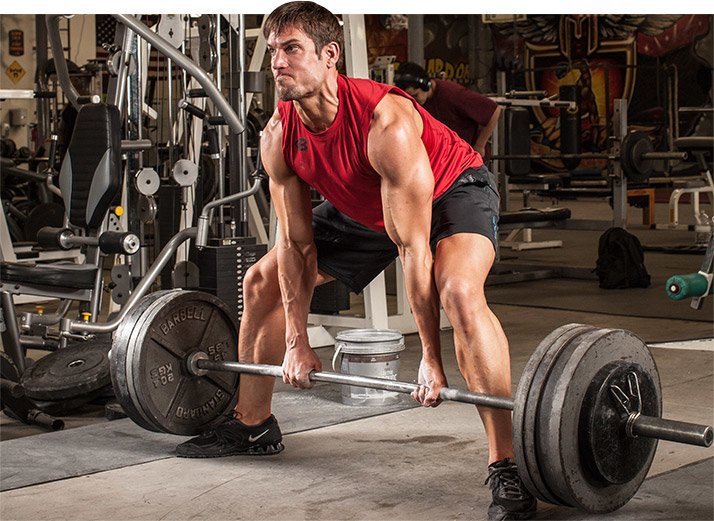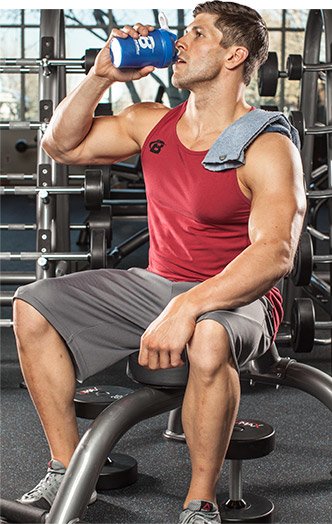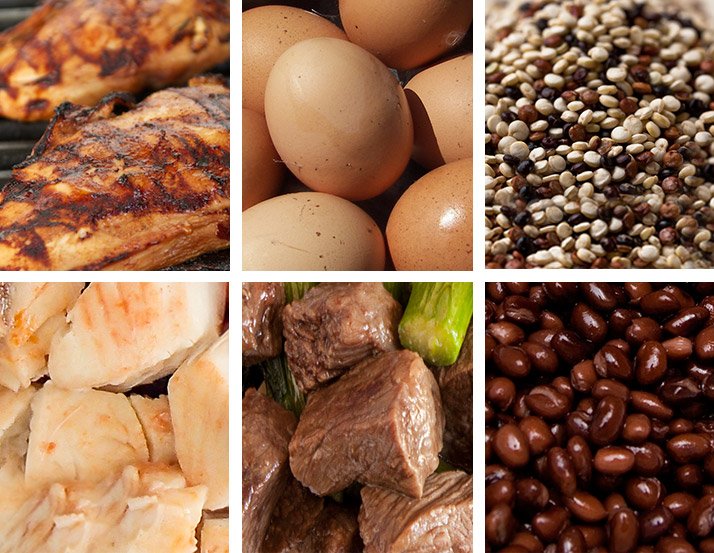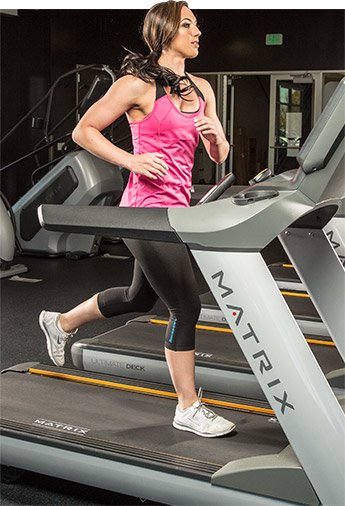
4 Classic Training Ideas: Fact Or Fiction?
New research is refining how we think about training and nutrition. Get the truth behind the "anabolic window," how much protein you need to eat, and more!
It's kind of hip these days for coaches and gym-goers to scoff at scholarly databases like PubMed—and really, studies altogether—as sources of fitness info. "Naw, I'll stick to what works in the gym," they say—as if that's something simple that never changes! Luckily, you don't have to have it one way or the other.
In recent years, a number of well-designed studies have taken aim at some of the most tightly held gym "laws" about nutrition, intensity, and supplementation. In nearly all cases, they didn't disprove what you're probably doing right now, but rather refined it, opening up new ways to build mass, get lean, and eat right, with less stress. This is science you can put to work right away!
Idea 1: Bigger weights will produce bigger gains
Here's what we know: Our muscles are extremely adaptive to the stimulus we apply to them, and resistance training is our strongest activator of muscle growth. But beyond that, things can get a little confusing.
For example, many people have held that the most important stimulus for muscle growth is the load placed on the muscle. It has been posited that an intensity load greater than 60 percent of your one-rep max (1RM) is absolutely necessary to elicit increases in muscle size.1,2 Others have suggested that muscle growth is maximized when lifting weights that are between 80 and 95 percent of 1RM.3 Big weights, big eating, big muscles—it all makes sense, right?

Recent research has us questioning these rules. Several studies have shown that the use of weights as low as 30 percent of 1RM can be equally as effective at stimulating muscle growth when performed to failure.4,5,6 Burd and colleagues had men train with either 90 percent or 30 percent of 1RM. The men using 30 percent 1RM were further divided into two subgroups: one that was matched for the work performed by the 90 percent 1RM group, and another that continued repetitions to failure using 30 percent 1RM. The results showed that muscle protein synthesis increased to the same degree in the 90 and 30 percent 1RM-to-failure groups, while the 30 percent work-matched group fell short.
How to grow muscle using light weights
- Track and increase total pounds lifted
- Work to failure at least some of the time
- Focus on mind-muscle connection
- Use intensity-boosting techniques: dropsets, slow-reps, 1-1/2 reps
- Eat and supplement for muscle growth!
Verdict
The takeaway here isn't "Don't lift heavy." It's more like, "You don't only need to lift heavy." These studies uncover how low-load and high-load resistance training can produce similar anabolic responses and gains in muscle size, highlighting the importance of tracking the total work you perform—as well as lifting to failure if your goal is muscle growth.
Idea 2: There's an "anabolic window"

Slugging down a post-workout protein shake after a solid workout becomes second nature to most bodybuilders. This has been ingrained in us for so long, it's become an unofficial law of the gym to use what's been called the "window of opportunity," or just the "anabolic window." But, in recent years, it's become clear that this arbitrary timeframe isn't as crucial as we once believed.
It's been known for years that when essential amino acids and carbohydrates are consumed three hours after exercise, as opposed to one hour after exercise, the effect on muscle protein synthesis is no different.7 Both time-points prove to be satisfactory for promoting muscle growth. However, what if the window was even larger—like a whole day?
In a long-term training study, Hoffman and colleagues investigated the effect of protein supplementation timing on body composition and strength measures.8 During a 10-week resistance training program, trained men consumed protein supplements either in the morning and evening, or immediately before and immediately after workouts. The timing of protein supplementation didn't provide any added benefit for the measures of body composition or strength over course of the study.
Verdict
Take your shake if it's part of your gym ritual, but don't fool yourself into thinking it's any more important than everything else you eat. Protein intake over the course of the day appears to be more important in eliciting in muscle growth than proximity to a workout.
Idea 3: More protein is better
High-protein diets are finally becoming widely accepted as safe and effective for improving your physique—and it's about time! But is there an upper limit for reaping the benefits?
Here's what we know: Muscle hypertrophy occurs when muscle protein synthesis is greater than muscle protein breakdown. We also know that a high-protein meal is capable of sparking muscle protein synthesis. However, recent research has indicated that the anabolic effect reaches a plateau more quickly than many realize.

In a recent study, trained men weighing approximately 175 pounds drank different amounts of whey protein following a single bout of resistance exercise to investigate the ensuing anabolic effect. Muscle protein synthesis reached an upper limit with the ingestion of 20 grams of whey protein, whereas 40 grams of whey protein failed to further promote muscle protein synthesis.9
Similar parameters have been shown for other protein sources. For example, a moderate 30-gram portion of lean beef protein has shown to be equally as effective as a gut-busting 90 grams.10 Similarly, 20 grams of egg protein maximally stimulated muscle protein synthesis in men, while 40 grams of egg protein didn't provide any further benefit.11 This refractory response is known as the "muscle full" effect.
Verdict
Because of the plateau effect on muscle protein synthesis, focusing on the amount of protein per meal is a better approach than the amount of protein per day. Save your money and maximize the muscle-building benefits of protein by eating around 0.12 grams per pound of body weight per meal, rather than cramming in high doses of protein to meet a daily standard.
Idea 4: Fasted cardio maximizes fat loss

Prior to consuming breakfast, it's common practice to perform aerobic exercise in an attempt to maximize fat loss. Why? Well, upon waking up from a night's sleep, the body is in a fasted state. Glycogen and insulin levels are low, and, in theory, the body should shift energy utilization away from carbohydrates, and use more stored fat for fuel.
However, a recent study showed that fasted cardio did not provide any further benefit compared to morning cardio in a fed state.12 Over the four-week study, non-obese, college-aged females followed a hypocaloric (low-calorie) diet and performed one hour of aerobic exercise three days per week. They were provided breakfast either immediately prior to exercise, or immediately following exercise. Although short-term, the results showed no difference in fat loss when comparing those who performed cardio in a fasted or fed state.
Verdict
Some people take this study as a sign that you shouldn't perform fasted cardio. I wouldn't go that far. Rather, just follow personal preference, since fasted and fed cardio appear to offer similar benefits to fat loss.
However, those attempting to maintain muscle mass while losing fat should be cautious with fasted cardio. Upon waking up, our muscles are in a catabolic state, and fasted cardio can elevate the use of protein as fuel.13 These athletes should consider sipping on fast-digesting protein or BCAAs before or during morning cardio to limit muscle loss.
References
- McDonagh, M. J. N., & Davies, C. T. M. (1984). Adaptive response of mammalian skeletal muscle to exercise with high loads. European Journal of Applied Physiology and Occupational Physiology, 52(2), 139-155.
- Wernbom, M., Augustsson, J., & Thomee, R. (2007). The influence of frequency, intensity, volume and mode of strength training on whole muscle cross-sectional area in humans. Sports Medicine, 37(3), 225-264.
- Fry, A. C. (2004). The role of resistance exercise intensity on muscle fibre adaptations. Sports Medicine, 34(10), 663-679.
- Burd, N. A., West, D. W., Staples, A. W., Atherton, P. J., Baker, J. M., Moore, D. R., ... & Phillips, S. M. (2010). Low-load high volume resistance exercise stimulates muscle protein synthesis more than high-load low volume resistance exercise in young men. PloS One, 5(8), e12033.
- Mitchell, C. J., Churchward-Venne, T. A., West, D. W., Burd, N. A., Breen, L., Baker, S. K., & Phillips, S. M. (2012). Resistance exercise load does not determine training-mediated hypertrophic gains in young men. Journal of Applied Physiology, 113(1), 71-77.
- Ogasawara, R., Loenneke, J. P., Thiebaud, R. S., & Abe, T. (2013). Low-load bench press training to fatigue results in muscle hypertrophy similar to high-load bench press training. International Journal of Clinical Medicine, 4(02), 114.
- Rasmussen, B. B., Tipton, K. D., Miller, S. L., Wolf, S. E., & Wolfe, R. R. (2000). An oral essential amino acid-carbohydrate supplement enhances muscle protein anabolism after resistance exercise. Journal of Applied Physiology, 88(2), 386-392.
- Hoffman, J. R., Ratamess, N. A., Tranchina, C. P., Rashti, S. L., Kang, J., & Faigenbaum, A. D. (2009). Effect of protein-supplement timing on strength, power, and body-composition changes in resistance-trained men. International Journal of Sport Nutrition, 19(2), 172.
- Witard, O. C., Jackman, S. R., Breen, L., Smith, K., Selby, A., & Tipton, K. D. (2014). Myofibrillar muscle protein synthesis rates subsequent to a meal in response to increasing doses of whey protein at rest and after resistance exercise. The American Journal of Clinical Nutrition, 99(1), 86-95.
- Symons, T. B., Sheffield-Moore, M., Wolfe, R. R., & Paddon-Jones, D. (2009). A moderate serving of high-quality protein maximally stimulates skeletal muscle protein synthesis in young and elderly subjects. Journal of the American Dietetic Association, 109(9), 1582-1586.
- Moore, D. R., Robinson, M. J., Fry, J. L., Tang, J. E., Glover, E. I., Wilkinson, S. B., ... & Phillips, S. M. (2009). Ingested protein dose response of muscle and albumin protein synthesis after resistance exercise in young men. The American Journal of Clinical Nutrition, 89(1), 161-168.
- Schoenfeld, B. J., Aragon, A. A., Wilborn, C. D., Krieger, J. W., & Sonmez, G. T. (2014). Body composition changes associated with fasted versus non-fasted aerobic exercise. Journal of the International Society of Sports Nutrition, 11(1), 54.
- Lemon, P. W., & Nagle, F. J. (1980). Effects of exercise on protein and amino acid metabolism. Medicine and Science in Sports and Exercise, 13(3), 141-149.

